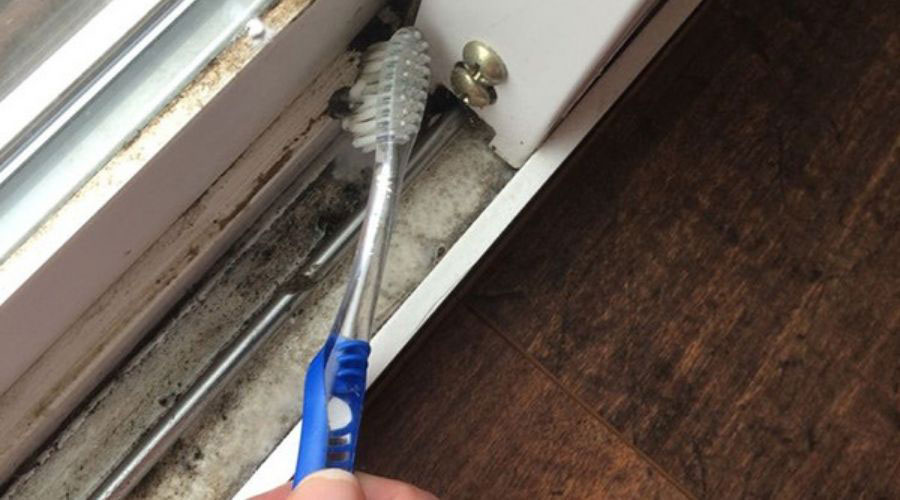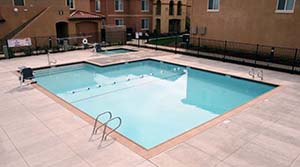
If you are like me, then the view out your patio door was one of the selling points for your home. That is why it can be so upsetting when that glass starts to get cloudy or fogged up with condensation. However, can you actually fix a double-paned glass window or door?
You can indeed fix condensation trapped in glass. Fog in your double-paned glass door is from water seeping into the factory seal. To do this, use a long brush to physically remove the debris through a hole drilled in the frame.
If that is not effective, try flushing alcohol between the panes or separate the panes and clean each individually. All these techniques are only temporary but can clear the issue until a replacement is possible.
Cleaning out the space between the double-paned glass is straightforward but should be done with great care. Before we get into how to clean this condensation out, let’s first go over the basics to diagnose the issue correctly.
How are Double-Paned Glass Doors Constructed?
A single pane of glass can keep out the elements but does not make a good insulator. To describe the ability of a material to transmit heat, we use what is called the U-value. A fabric that transfers heat energy well has a high value and insulates heat has a low value.
The table below gives you some materials with their corresponding U-value to give you an idea of the range of heat transmission:
| Material | U-value |
|---|---|
| Sheet metal | 1.2 |
| 2” poured concrete | 0.99 |
| 1” thick wood | 0.64 |
| 8” Masonry Brick | 0.41 |
| 3” Fiberglass insulation | 0.09 |
On this scale, a single pane of glass has a U-value of about 1.0, which means it is a very poor insulator.
The second pane of glass decreases heat transfer to keep your house warm in the winter and cool in the summer. This part of the glass brings the U-value down to about 0.5. This insulating effect is not because of the additional glass pane but the air space created between the two layers.

The glass panes separate by about ¼ inch. That gap fills with a gas such as Argon or Krypton, further improving this insulating factor and saving energy costs. These heavy, inert gasses help decrease heat transmission further, bringing the U-value down to about 0.35.
The dry Argon gas between the window panes reduces energy costs significantly for your home, and the hermetic (airtight) seal prevents any condensation inside as temperatures fluctuate. But, this seal can become compromised over the lifespan of the windows, allowing ambient air to seep inside.
How Do You Stop Condensation on a Patio Door?
Fog is the effect caused by condensation as tiny water droplets build on the surface. It generally happens either due to high humidity (think your bathroom mirror after a shower) or by temperature differentials (your car’s windows on a cold day.)
If you can wipe the condensation away from your glass sliding door, then it means your room is too humid. In this case, there is no problem with the door itself. Usually, you can get a fan or use a desiccant in the room to absorb moisture.
But, if the condensation is between the glass panes, you have more significant problems, meaning the hermetic seal compromises, and air or water leaks into the insulation space.
Not only will this leak allow moisture to enter and cause fog, but it also reduces the insulative factors of the window, bringing up energy costs.

What is a Broken Thermal Seal in a Sliding Patio Door?
The thermal seal holds the Argon gas between the two glass panes. This gas is denser than air and does not conduct heat well.
As discussed above, this can reduce the U-value of the windows and make the house more comfortable and buffer temperature changes.
However, this seal does have a limited lifespan and will eventually leak. Environmental factors can contribute to the degradation of this seal, so if your home experiences high winds, dramatic shifts in temperature, or flooding, it will reduce the lifespan.
Generally, most glass door manufacturers tell you you need to replace it because you will not get an airtight seal after dismantling and cleaning the glass.
How Do You Fix a Foggy Patio Door?
Although you cannot fix the thermal seal on your patio door, you may be able to clean up the fog by removing the condensation.
Although it probably will not be a permanent fix, it will allow you to fix the fog issue and enjoy your outdoor views once again.
Remember that your door will not have the same insulating properties, and your home energy costs could go up.
Whether or not you want to replace the door is entirely up to you, but some common reasons people might not want to replace it include:
- High costs of new door/installation
- Long-wait time for orders or repair companies
- Age of home
- Future plans to renovate
If you fall into one of these categories or have other reasons you cannot replace it, cleaning may be the way to go. The following procedures will help you get the results you want.
A little disclaimer; there is a chance you could break the door while trying to repair it, so be careful and wear proper safety clothing for glass. But, if the door already needs to be replaced, then you have nothing to lose by trying to fix it yourself.
1. Prepare Your Work Area
This work needs to be done in a dry, covered setting to prevent further damage to the door. Depending on the technique used, the door may need to sit there for a day or two, so plan accordingly.
Lay down a tarp or cloth onto the floor to catch any broken glass or debris, then set up two sawhorses to place the door on.

2. Remove the Sliding Door from the Frame
Because every door is slightly different, you will have to look at how your’s is attached. Some will require you to remove a piece of the frame to access the door slider, usually held on by a few screws. For others, you may need to loosen the adjustment screws at the base to release the top of the door.
You can lift other doors out from the inside. First, slide the door open about halfway and then lift it straight up above the track. Next, pull the bottom of the door towards the inside of the room.
This should free it from the upper track. Have a second person grab the top end of the door and guide it over to the sawhorses.
Take care to lay the door flat on the sawhorses, supporting it by the frame and not the glass.
3. Decide Which Cleaning Method to Use
There are three different methods you can use depending on your door type and comfort level. But, essentially, we recommend three general techniques:
- Physically removing the fog/scum from between the glass layers using a rag or brush
- Flushing alcohol through the air gap to clean and de-water
- Separating the panels and cleaning each individually
Now that you have your door down, inspect it to see if you can remove the trim and separate the two layers of glass. If not, then you might need to use one of the first two methods.
Before deciding which method to use, read the procedures for all three and decide which you are most comfortable with.
Physically Removing the Fog or Scum Buildup from the Glass
If you can get away with using this method, it may be the easiest. However, it usually only works when the issue is relatively new or only a small area is affected.
First, drill a small hole into the seal between the two panes of glass, taking care not to break either pane. Next, insert a pipe cleaner, or a drain snake covered in pantyhose into the gap and scrub the debris and film. If a drain snake is not available, a wire coat hanger could also work.

Flushing Alcohol Through the Air Gap to Clean & De-Water
You may consider rubbing alcohol if the fog or scum is excessive and you cannot physically clean it.
To do this, you will drill two holes in the thermal seal large enough to put a vinyl tube into. If you have a drill bit for glass, you could penetrate directly through the panel. One hole should be at the top of the door frame and the other at the bottom.
Attache a squeeze bottle full of isopropyl alcohol to the top tube and a water bottle to catch the alcohol to the bottom tubing.
Next, squirt the cleaner through the glass panes and allow it to run down to the drain bottle. You may need to repeat this several times before flipping the door over to focus on the other pane.
Be careful with the alcohol and work in a well-ventilated environment, as it is very flammable and the fumes are dangerous to breathe.
After you have flushed most of the debris and streaks away, repeat once more with new alcohol. Allow it to dry for a day or two before sealing the holes with painter’s putty.
Alternatively, you can stuff cotton balls into the holes in the thermal seal to allow some airflow but prevent debris or bugs from getting in. Use epoxy or clear tape for holes drilled directly through the glass.
Separating the Panels and Cleaning each Individually
Separating the two panels and cleaning them can be the most effective method. Check to see if you can access the panels by removing the screws around the frame. You can also check your door model online to see if this is possible.
First, remove all screws and then pull the metal joints away from the glass panes, taking care not to crack them. Have somebody help to lift and flip over the top layer of glass for cleaning.
Repeat this step to clean both sides of the glass that face the air gap.
4. Add a Desiccant & Reseal the Door
A desiccant is a hydrophilic compound and absorbs moisture. Often, the manufacturer of your door will have included a desiccant layer to the thermal seal of the door when it was new.
No matter which option above you choose to remedy your issue, adding a desiccant can prolong until you maintain the door again.
These can usually be purchased at hardware or electronics stores and include brand names such as damp-rid.
Pour a small amount of this powder into the hole you created or add before putting the two glass panels back together.
Next, use caulk, flex-seal tape, or a similar product to seal the holes you have created or the joint between the two layers of glass to prevent future water seepage.

5. Reinsert the Door into the Frame
Now that you have cleaned and resealed the door, you want to inspect the frame and sliding tracks. Often, with wooden frames, standing water is what caused rot and water seepage in the first place. So, to address the root cause of the problem, you need to reduce the amount of water stuck in the tracks.
Check to see how water is getting into the tracks. Usually, this means cleaning or repairing gutters, leveling deck planks, or ensuring proper drainage.
Next, clean out the tracks to remove any debris and add a graphite or silicone lubricant, if needed.
Lastly, reinsert the door back into the frame in the reverse order to how you removed it. Always use two people for this to prevent damage to the door, trim, or yourself.
Once you replace the door, test to make sure it slides easily and that the lock still lines up correctly.
At this point, you should once again have a lovely clear patio door to enjoy an unobscured view. Keep in mind that the thermal insulation value of the door reduces, and your energy costs will go up. Regardless, we hope that these tips have helped you add more life to your door until you can get it replaced.
Sources













